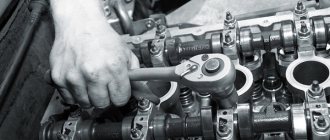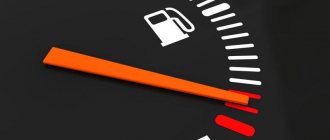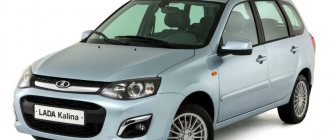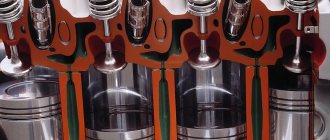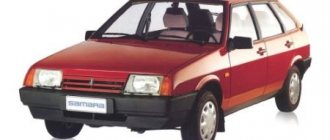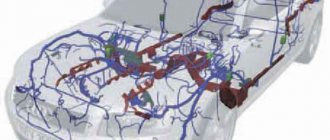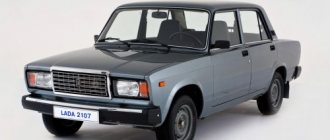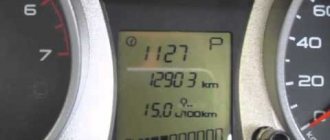Of course, Russia, over its more than thousand-year history, has enough examples for well-deserved pride. However, the auto industry is clearly not one of them.
Lada Priora is considered one of the most controversial achievements of the automotive industry of the Russian Federation. On the one hand, it was well received both by customers, as evidenced by excellent sales at the time of release, and by representatives of the automotive press. On the other hand, the joy of the owners knew no bounds only because of the relatively low cost of this vehicle. As soon as all its shortcomings, characteristic of most cars from the Togliatti company AvtoVAZ, were revealed, Priora began to be hurled with choice curses.
Options for solving the problem of Lada Priora with increased idle consumption
You should not base your car’s fuel consumption on the basis of the indicators provided by the on-board computer. As is known, such technologies, especially considering that they were produced in Russia, have low accuracy. To check the actual consumption, you need to use the often practiced “from refueling to refueling” method:
- first, the fuel tank is completely filled;
- the flow meter counter is set to zero;
- driving is carried out until a signal lights up on the dashboard, indicating that the fuel level is close to zero;
- then the car is refueled again to a full tank.
As a result, you need to look at the refueling machine's meter to see how much gasoline was actually filled, then compare this data with what is displayed on the meter, and make basic calculations that will show the real consumption.
If concerns about increased consumption are confirmed, you will have to worry about replacing some components. Which ones exactly cannot be determined at random, therefore preliminary computer diagnostics and visual assessment will be required.
There is a high probability that reflashing the engine will help normalize consumption. The latest programs can reduce its value at idle to the optimal 0.5-1 liters per 100 kilometers.
However, the problem may remain unresolved even after taking all the indicated measures - cases of factory defects in Lada Priora cars, regardless of the year of manufacture, are very common. In this case, there is nothing else to do but contact representatives of the official dealer in your region.
And, finally, the best recommendation that can be given to the owner of a Priora is to seriously think about buying a car of another brand, which has much higher reliability and efficiency indicators at a comparable cost of the car itself and its service.
Theoretical indicators
The factory specifications of the Priora indicate the fuel consumption of this car. But the data is averaged and does not reflect the full picture. The manufacturer claims that this 16-valve machine with a power of 98 horsepower and a manual transmission “eats” 6.9 liters per hundred kilometers.
And at the same time, the flagship model, which drives an automatic transmission with five gears, consumes 6.6 liters per 100 km with 106 horsepower. But a variation of a car without an automatic transmission with 106 horsepower “eats” 6.8 liters, covering the same distance. All calculations of Lada Priora costs per 100 km are made under mixed mode conditions.
The table shows the consumption of a 16-valve Lada Priora with a 1.6-liter gas tank while traveling along a highway or a busy city.
| Mode | 98 l. With. with MT | 106 l. With. with 5AT | 106 l. With. with MT |
| Highway (outside the city) 90 km per hour | 5.5 liters per hundred kilometers | 5.5 l per 100 km | 5.6 liters per 100 km |
| Around town | 9.1 l/100 km | 8.5 liters/100 km | 8.9 liters/100 km |
| Mixed | 6.9 l. per 100 km | 6.6 l liters/100 km | 6.8 l/100 km |
Based on the indicators, we can conclude that the highway is the most economical mode. Gasoline consumption on the Priora, regardless of power and gearbox, is noticeably lower.
The 8-valve Priora 1.6 MT produces 90 horsepower on a 100-kilometer country road using 6.2 liters. While it will travel the same amount on city streets, it will already consume 8.8 liters.
But 1.8 MT 123 liters. With. on a long, flat path it will spend 5.4 liters, driving a hundred kilometers, and on busy streets the same distance will require burning 9.8 liters of gasoline.
Lada Priora (2020). increased fuel consumption
| List of possible faults | Diagnostics | Elimination methods |
| The air filter element is clogged | Check the condition of the air filter replacement element | Blow or replace the air filter element |
| Leaking power system | Smell of gasoline, fuel leaks | Check the tightness of the connections of the fuel system elements; If a malfunction is detected, replace the corresponding components |
| Spark plugs are faulty: current leakage through cracks in the insulator or carbon deposits on the heat cone, poor contact of the central electrode | Spark plugs are checked on a special stand at a service station. The absence of external damage and sparking between the electrodes on the inverted spark plug does not allow us to draw a conclusion about its functionality | Replace spark plugs |
| Throttle actuator malfunction | Check the travel of the gas pedal, the clearance in the drive (free play of the pedal), make sure that the cable and pedal are not jammed | Replace faulty parts, lubricate the cable with engine oil |
| The idle speed controller or its circuits are faulty | Replace the regulator with a known good one. | Replace the faulty regulator |
| The throttle valve does not close completely | The gap between the throttle valve and the walls of the housing is visible in the light | Replace the throttle assembly |
| Increased pressure in the fuel line due to a faulty pressure regulator | Check the pressure in the fuel system with a pressure gauge (no more than 3.5 bar) | Replace the faulty regulator |
| Leaking injectors | Check the injectors | Replace faulty injectors |
| The coolant temperature sensor or its circuit is faulty | Check the sensor resistance with an ohmmeter at different temperatures | Restore contact in electrical circuits, replace the faulty sensor |
| The oxygen concentration sensor is faulty | You can evaluate the performance of the oxygen concentration sensor and the reliability of its electrical circuit connections using diagnostic equipment at a service station | Restore damaged electrical circuits, replace faulty sensor |
| The ECU or its circuits are faulty | To check, replace the ECU with a known good one. | Replace the faulty ECU, restore damaged electrical circuits |
| Low compression in the engine cylinders (less than 11.0 bar): clearances in the drive are not adjusted, wear or damage to the valves, their guides and seats, stuck or broken piston rings | Check compression | Adjust the clearances in the valve drive. Replace faulty parts |
| The throttle position sensor, absolute pressure and air temperature sensors in the intake manifold or their circuits are faulty | Check the sensors and their circuits | Restore contact in the electrical circuits, replace the faulty sensor(s) |
| Increased resistance to gas movement in the exhaust system | Inspect the exhaust system for dented or damaged pipes, check the condition of the catalytic converter | Replace damaged exhaust system components |
| Malfunctions of the chassis and brake system | Check the chassis and brake system | Adjust the wheel alignment angles, replace faulty chassis parts, and troubleshoot the brake system. |
What are the reasons for the high fuel consumption of the VAZ-2109 carburetor
Fuel system
It is in the fuel system that the mystery of increased engine fuel consumption may lie.
First of all, you need to check the pressure in the fuel pipes and fuel rail. Several parts that have failed for various reasons can contribute to this effect. Dirty fuel module mesh
The first two items to check are the fuel pump and the fuel filter. Dismantling the fuel module may be a clue, since the filter mesh could simply be clogged.
But the filter is not visible, so you just have to change it.
Low-quality fuel, which is saturated in the modern gasoline market, as well as low-quality spare parts can cause this unit to fail ahead of time.
Dirty fuel filter
The second element that can cause this is the throttle valve. Contamination of this element can lead to its position jamming and increased consumption. The solution is to dismantle and clean the throttle.
A dirty throttle valve can be easily cleaned with WD-40
If the fuel system has been checked, all elements have been replaced and cleaned, but the consumption is still high, you should pay attention to the injectors.
pros
Fuel consumption calculator: calculate fuel consumption
"Lada Priora", without a doubt, captivated many with its characteristics and price. However, its engine has a number of pros and cons, knowing which you can avoid many problems. Among the advantages are the following:
- Reliability. Yes, the Lada engine is far from the BMW, but it copes with the assigned tasks with a bang. Simple and good-quality, it can last up to 200 thousand kilometers, and after major repairs it can last the same amount.
- Cheap consumables. Engine parts can hardly be called cheap by definition, but repairs from Priora will cost much less than cars from foreign manufacturers.
- The power for a lightweight Lada 2170 is quite sufficient to accelerate at a sufficient speed. The 21126 engine with 16 valves can produce power up to 100 horsepower and reach speeds of up to 180 km/h.
- Environmentally friendly. The Priora engine fully complies with European quality standards and emits less exhaust gases into the atmosphere than its predecessors.
- Good traction at both high and low speeds appeared after modification of the exhaust manifold.
- The efficiency of the 16-valve engine is significantly greater than that of previous generations of Lada due to its design. Because of this, the car consumes less fuel.
As you can see, there are many advantages. It is not difficult to understand why the Lada Priora became so popular in Russia. The Russian-made car was created for our roads, and its design took into account all the pitfalls. But not a single thing can be ideal, so disadvantages can also be found in the VAZ-2170.
Ways to eliminate the “sore”
If such a problem occurs, you need to look for which node is to blame analytically, checking all the specified sensors.
First, let's consider the following option for correcting the problem situation. Let's assume that a VAZ 2110 has high revs. An examination of the suspected components for faulty components showed that the throttle position sensor has traces of rust. It is located directly above the throttle valve. Measurements with a voltmeter showed that when the engine is idling, the voltage on it remains high - which means it does not close the damper.
How to fix the problem? For this we only need a screwdriver. Let's begin the procedure.
- By disconnecting the terminal block and also unscrewing two screws, we dismantle the assembly.
- We notice that traces of rust inside interfere with the movement of the wheel that regulates the position of the damper.
- We fill the insides of the defective device with a penetrating anti-rust aerosol.
- Use a development screwdriver to turn the wheel.
- We reassemble in reverse order.
Check to see if the engine idle speed is now high. The problem should go away.
Now let's look at another case. Let's say we have high idle speed in a VAZ 2114. This is what we do when faced with this situation.
When clarifying the circumstances of the problem under investigation, we always initially check the operation of the idle speed sensor. This device consists of a needle built inside an electromagnetic coil. The needle either moves inside the coil, moving away from the hole in the throttle pipe, or moves out, closing this hole, thereby stopping the supply of air for combustion of the mixture.
Also read about adjusting engine idle speed and repairing a Tavria car muffler with your own hands. This element is located at the throttle valve, opposite the gas pedal cable. To diagnose it, we pull out the terminal block from it, start the car, after which we see that we still have high engine speeds that have not changed at idle. Then we remove this defective unit, then clean it or replace it. For work we take:
- Unscrew the two screws. We take out the broken node.
- We connect the wiring to it. Turn on the ignition. If the needle of the device moves slightly inside the coil to the touch, then it is working.
- If the needle does not react when an electric current is applied, wash the device with a toothbrush using gasoline.
- We do the assembly in reverse order.
When you cannot restore the functionality of this unit with your own hands, it is better to purchase a new one. Moreover, the cost of spare parts is low.
Other fixes
Of course, the options considered do not exhaust the possible ways to correct the shortcoming when high speeds are noticed precisely on a warm engine. To further study the most common situations, let's look at the case of a malfunctioning mass air flow sensor.
This device is responsible for supplying the correct portions of air for combustion of the mixture, and also provides data to the electronic control unit about these portions, so that the unit proportions the supplied portions of gasoline.
Lada Priora (2013+). Vibrations when accelerating and decelerating
| Possible causes of malfunction | Troubleshooting |
| Worn inner joint | Replace the hinge or drive assembly |
| The intermediate shaft is deformed | Replace the drive assembly |
| Worn intermediate bearing | Remove the intermediate support bracket and check the play in the bearing. Replace the faulty bearing |
Kia rio: fuel consumption per 100 km
Lada Priora (2013+).
Battery faults
The battery is discharged. The starter does not turn the engine crankshaft or turns it slowly, the lamps are dim.
Cause of malfunction Methods of elimination The car has not been used for a long time. Charge the battery using a charger or in another car. The belt tension is loose. Tighten the alternator drive belt. When the engine is turned off, many electrical consumers are running (the head unit of the sound reproduction system, etc.) Reduce the number of consumers operating from the battery Damage to the insulation of electrical circuits, current leakage on the surface of the battery Check the leakage current (no more than 11 mA when consumers are disconnected), clean battery surface
Beware of acid! The generator is faulty See diagnostics of generator faults Short circuit between the plates (“boiling” of the electrolyte, local heating of the battery) Replace the battery
Lada Priora (2013+).
The low battery indicator light is on
| The battery low charge indicator is on. The vehicle's on-board voltage is below 15 V. | |
| Cause of malfunction | Elimination methods |
| The generator drive belt tension is loose | Tighten your belt |
| The voltage regulator is faulty. | Replace regulator |
| The diodes of the rectifier unit are damaged | Replace the rectifier unit |
| The connection of the excitation winding terminals with the slip rings is broken, there is a short circuit or a break in the winding | Solder the leads, replace the generator rotor or generator assembly |
| Open circuit or short circuit in the stator winding, shorting it to ground (when shorted, the generator howls) | Check the winding with an ohmmeter. Replace the stator or generator assembly |
Lada Priora (2013+).
The vehicle's on-board voltage is higher than 15.1
| The vehicle's on-board voltage is higher than 15.1 V | |
| Cause of malfunction | Elimination methods |
| Damaged voltage regulator | Replace voltage regulator |
Video on the topic “Lada Priora (2013+). INCREASED FUEL CONSUMPTION"
What affects consumption or why the car consumes gasoline. From the experience of my TAZ Kalina
VAZ is the result of cleaning the mass air flow sensor and throttle body using spark plugs
We measure the consumption on Priora part 3
What affects fuel consumption?
Like overall fuel consumption, which I already discussed in this article, fuel consumption at idle is influenced by many factors, including:
- The serviceability of the engine, as well as all systems that relate to fuel consumption (stove, air conditioning, etc.);
- Engine capacity;
- Ambient temperature;
- Number of included energy consumers (“air conditioner”, stove, headlights, radio, etc.);
- Fuel quality. If, for example, you fill in 92 instead of 95, then be prepared for the consumption to increase. In addition, if the fuel is of low quality, then its consumption will be higher by about 15-20%, depending on the “degree of lousiness”.
To begin with, I will say that if we talk about approximate figures, then fuel consumption at idle speed per hour is equal to the car’s consumption per 100 km divided by 10. That is, if your consumption is 7 liters. per 100 km, then divide 7 liters. by 10 and we get 0.7 liters.
During the cold season
In winter, any car more often requires filling the tank. Fuel is spent on heating the interior, braking, turning and other elements of driving, which turn into stunts when there is a lot of snow on the street, the number of accidents increases, they appear out of nowhere, and traffic jams suddenly disappear. Lada Priora moves confidently in any weather, because it has a very convenient body shape and dimensions. This is what will help reduce fuel consumption.
Driving around the city requires a special driving style. Having developed it, each driver will take care of the budget and expenses. It should be remembered that a sudden change of direction, braking and speeding up is not only a risk, but also a waste of fuel. If you find yourself in a traffic jam, it is better to turn off the engine. More effective ways to increase the savings rate in winter have not yet been invented. But by following these recommendations, you can achieve a lot. Worth a try.
Features of consumption depending on the gearbox
The automatic Lada Granta consumes more fuel, since the manual gearbox is controlled by the driver, and the automatic switches independently, with a slight delay. For a Lada Granta with a manual transmission, the gear engaged when driving is very important. By analyzing his daily journey, the driver can determine the real gas mileage of his car. According to reviews from Lada Granta car owners, it turns out that the following is consumed per 100 km:
- in the city - automatic transmission 9-12 l, manual transmission 7-11 l;
- on the highway - automatic transmission 8-9.5 l, manual transmission 6-7 l.
In winter the indicators are maximum, in summer they are minimum. Thus, a tank volume of 50 liters allows you to travel more than 500 km. In city mode, drivers are forced to combine aggressive and quiet driving, hence the average gas consumption of a run-in Lada Granta is 8 l/100 km. Using engine braking, choosing the right gear (on a manual transmission) and driving only in the far right lane behind public transport will help reduce fuel consumption by 1.5-2 liters. On a suburban highway, when driving smoothly on a flat road surface, values of 5 liters are observed. However, with sharp braking and a quick start, with constant overtaking, the consumption increases to 6-7 liters.
Lada Priora details about fuel consumption
Nowadays, the issue of fuel consumption has become as relevant as ever, because gasoline prices are rising every day. Car owners always try to choose a more economical model, and Lada Priora is one of them. The fuel consumption of the Priora will please motorists, because it turned out to be pleasantly profitable. It may depend directly on the configuration of the car, but since, basically, they all have sixteen valves, the consumption of a 16-valve Priora per 100 km is not particularly different from other models.
Initial characteristics
Car manufacturers always indicate the technical characteristics of their products with some errors. And Priora, produced by the automobile company AvtoVAZ, is perhaps no exception. Initial data for this car included gasoline consumption of 6.8 to 7.3 liters/100 km. But the real data of this model fluctuate a little and not even in the smallest amounts. And the consumption rates for such a Lada per 100 km are already different. Now we will try to show it to you.
| Engine | Consumption (highway) | Consumption (city) | Consumption (mixed cycle) |
| 1.6i 98 hp 5-mech | 5.5 l/100 km | 9.1 l/100 km | 6.9 l/100 km |
| 1.6i 106 hp 5-mech | 5.6 l/100 km | 8.9 l/100 km | 6.8 l/100 km |
| 1.6i 106 hp 5-rob | 5.5 l/100 km | 8.5 l/100 km | 6.6 l/100 km |
Driver surveys
To find out what kind of fuel consumption the Priora has per 100 km, it took observations from the drivers themselves, who were already able to verify the real figures in practice. These reviews are divided into several categories. Of 100 percent of respondents, most of the votes were given for the Priora's fuel consumption of 8-9 liters/100 km.
Further, with slightly fewer votes, we settled on data of 9-10 liters/100 km. The next results were consumption of 7-8 liters, which was voted for by one third of the drivers, the majority of those participating in the survey. Also, in the minority of votes, there were reviews (from large votes to small ones):
- 12 liters/100 km;
- 10-11 liters/100 km;
- 11-12 liters/100 km.
Inconsistency
From the above parameters, it can be understood that the stated technical characteristics do not exactly correspond to real figures. Much more - the data kindly provided by the owners differs somewhat from each other, leading far from the true indicators. Therefore, the actual fuel consumption of a Priora in the city is a very variable indicator. So, what then can gasoline consumption depend on? Let's do a short review.
Reasons for discrepancies
To give an accurate answer to what the average fuel consumption of the Lada Priora is, you need to take into account all the factors that influence higher or lower fuel consumption. The reasons may vary. These include:
- car color;
- engine condition;
- driver's driving technique;
- road condition;
- use of air conditioning, stove and other additional appliances;
- driving over 50 km/h with the windows open;
- time of year and others.
Car color
Some motorists argue that the cost may directly depend on the color of the car. For example, a light model consumes much less than its dark counterpart, but this is far from a guarantee.
American scientists have proven the influence of color. They found that this manifests itself especially in the warm season.
When a car heats up, it spends a lot of energy cooling the interior and, of course, fuel consumption increases. In the interiors of dark cars, during the hot season, the temperature was several degrees higher than in light-colored models. That is, the fuel consumption of the Priora station wagon (per hundred) in the summer will be less.
Winter
It's a difficult time of year for cars. Priora fuel consumption can vary significantly. The 16 valve Priora consumes more in winter. Firstly, when the engine is not warmed up, the gasoline consumption of the Lada Priora will be higher. Secondly, the increased complexity of roads that require the car to drift also increases fuel consumption. Thirdly, speed. The slower the car moves, the more gasoline it uses.
Lada Priora, which has 16 valves, is overall more economical than other cars with similar technical characteristics. In addition, if you wish, you can always convert it to gas consumption and significantly save your family budget.
Didn't find the information you are looking for? on our forum.
VAZ 2104 fuel consumption per 100 km, injector
VAZ 2115 rear light pinout
Adjusting the carburetor on a VAZ 2106
When starting off, a knock is heard from the front of the VAZ 2110
VAZ 2114 wipers do not return to their original position
VAZ carburetor does not start well when hot, causes and solutions
VAZ 2115 how to change wipers to
Installing the ignition on a VAZ 2107 carburetor, marks, gap in breaker contacts, checking ignition
Total
The factory fuel consumption figure for Priora with 16-valve engines is 6.6-6.9 liters per mixed “hundred”. In reality, the appetite ranges from 8 to 14 liters. in winter and 5.5-11 l. in summer.
It's an environmentally responsible thing to do and will indirectly help save fuel. We believe that cars require no maintenance other than worn brake pads, tires, shock absorbers and filters. However, as high-energy ignition systems move away to the cross electrodes, the gap becomes wider and the spark is less consistent and intense. Get yourself a fresh set of spark plugs for better gas mileage. And while you're at it, check your ignition coils and wiring harness.
Vacuum leaks are easily one of the most overlooked faults because we tend to assume the worst and miss stray suction entirely. Vacuum leaks often prevent detection. Since so many under-hood jobs rely on intake manifold vacuum, there are apparently miles and miles of vacuum hoses from bumper to bumper. Vacuum hoses are dry, as are tees and other connections. And when they do, they create vacuum leaks that can disrupt the electronic engine management system.
Increased fuel consumption can be caused by malfunctions in the fuel system, in the ECM, a clogged air filter, a clogged catalyst, incorrect operation of the air purge valve, or air leaks. Tire pressure and driving style also determine energy consumption.
Real reviews from owners about fuel consumption on the Lada Priora:
You get rough or unusually high idle and less power. The result is poor fuel economy. Fuel pressure regulators are typically flight vehicle components, but they can fail. A faulty fuel pressure regulator may or may not cause too much fuel pressure. Too much means high fuel consumption and poor performance.
14: Ignition coils and seat belts
However, high-energy ignition systems and sizzling temperatures take their toll on ignition components. Coil-based ignition systems virtually eliminate ignition wires. However, many traditional coil and distributor ignition systems remain. When you change spark plugs, try checking and, if necessary, replacing the ignition wires and coils while you're at it. This keeps the entire ignition system fresh and in addition to the ignition business.
Lada Priora, in operation for 3 years, 19,000 km mileage.
- I am a measured driver, so the “acceleration-deceleration” mode is not for me. Fuel consumption is interesting for sporting reasons. It suits me along with the car. In fact, during the run (see above), fuel consumption per 100 km never exceeded 8 liters in mixed mode.
Lada Priora, in operation for 4 years, volume 1.6.
As always, check the manufacturer's recommendation. Most never consider a positive PCV valve in the same thought process as fuel economy, but it can have an effect. This can also be a huge source of vacuum leaks.
It will also cost you in fuel economy since fuel has a high evaporation rate. A loose fill cap allows fuel to evaporate, which also causes problems with the evaporative emissions system. Cooling fans can either increase fuel consumption or completely destroy it. Inflexible steel fans will cost you power and fuel economy. The most efficient engine cooling fan is the thermostatic clutch fan. It engages and operates when needed and freewheels when not needed.
- I pay close attention to fuel consumption. I record all gas stations and often travel loaded. When loading, obviously a liter can be lost in fuel consumption. And so, within 7.5 liters, moreover, I did not observe gasoline consumption.
- I have an eight valve engine. And AI-92. Therefore, sometimes it comes out within 8.5 liters per hundred km. But I noticed that if you drive calmly, the fuel consumption per 100 km is much less - about 6.5 liters.
- I like the motor. Yes, gasoline consumption per 100 km may vary. It all depends on the load, starts from traffic lights, and the time of year. But on average, over six months, I calculated that I met 7 liters in fuel consumption. Worthy!
Car Lada Priora 1.6 16 V – 2 years, mileage 16 thousand.
18: Still fooling around with glasses?
Electric thermostatic cooling fans remain one of the biggest fuel savings. If you choose and take proper care, you can improve cooling and improve fuel economy. If you drive a classic car and are still traveling interstate with breakpoints, you are burning an excessive amount of fuel. Every time a spark plug misses, that's precious fuel lost in the tailpipe.
What is the fuel consumption of the Lada Priora at idle speed?
Of course, Russia, over its more than thousand-year history, has enough examples for well-deserved pride. However, the auto industry is clearly not one of them. Lada Priora is considered one of the most controversial achievements of the automotive industry of the Russian Federation. On the one hand, it was well received both by customers, as evidenced by excellent sales at the time of release, and by representatives of the automotive press. On the other hand, the joy of the owners knew no bounds only because of the relatively low cost of this vehicle. As soon as all its shortcomings, characteristic of most cars from the Togliatti company AvtoVAZ, were revealed, Priora began to be hurled with choice curses.
About the alarm
Alarm system with auto start, allows you to start the car for 5 - 10 minutes. Moreover, usually the default is 10 minutes, but you can set it to 5, on some alarms it’s 3 minutes.
You can set it to run automatically by time, for example:
- Will start before you arrive
- Or by time interval (every 2 hours),
- By temperature (warmed up - stopped - cooled down - started again).
- Well, of course, you can start it yourself from the window in the morning (this is if the car is parked in front of the windows).
The most common are points 1 and 4, and basically no one removes the factory settings; the machine “keeps on” for 10 minutes. (it is during this time that we will calculate fuel consumption below)
Removing and checking the idle air regulator
We remove the idle air control to check and replace. With the ignition off, release the latch. ...disconnect the engine management system wiring harness block from the regulator. Terminals “A”, “B”, “C” and “D” of the wiring harness block are connected, respectively, to terminals “67”, “66”, “65” and “64” of the controller. When the ignition is turned on, the voltage values (regulator control output signals) at these terminals change chaotically and therefore cannot be checked.
Using a Phillips screwdriver, unscrew the two screws securing the regulator to the throttle assembly...
...and remove the regulator from the throttle assembly socket.
The connection between the regulator and the throttle assembly is sealed with a rubber ring. Using a tester (in ohmmeter mode), we measure the resistance between the terminals of the regulator connector. For a working regulator, the resistance between terminals “A” and “B”, as well as “C” and “D” should be 40–80 ohms. Install the idle air control in the reverse order. Before installing a new regulator...
...using a caliper we check the distance between the end of the valve needle and the supporting surface of the regulator flange. The distance should be no more than 23 mm. This is necessary in order not to damage the regulator during installation - the regulator needle should not rest against the seat of the throttle assembly. It is necessary to take into account that if the specified distance for the new regulator is more than 23 mm, then it will be possible to retract the locking needle into the regulator only with the help of a special tester (at a service station). Before installing the idle air regulator, clean the valve seat, air duct and surface for the sealing ring in the throttle assembly. Apply a thin layer of engine oil to the new regulator O-ring.
The reliable carburetor engine control circuit has long been supplanted by flexible electronics. The latter consists of a control unit and sensors operating according to a specific program. This trend has made it possible to achieve an increase in power and a decrease in fuel consumption. However, with the advent of electronics, the control system has become more vulnerable to malfunctions.
Lada Priora 1.8 MT
Information from the manufacturer
In 2014, sales of the Lada Priora car began, the manufacturer of which is. The new version is equipped with an engine with a displacement of 1.8 liters and a power of 123 horsepower. Acceleration time from zero to hundreds has increased significantly compared to previous models - it is now 10.0 seconds. The maximum speed to which the updated Priora can be accelerated is 190 km/h. Consumption is 9.8 liters in the urban cycle and 5.4 liters on the highway.
The situation with real gasoline consumption
- Mikhail, Peter. Lada (VAZ) Priora 1.8 MT 2014. Overall, I’m happy with the car. For such little money I got the equipment I wanted. In terms of breakdowns, I haven’t encountered any yet. Consumption remains on average at 7.5 liters. I would like, of course, better sound insulation. Yes, and the seats could be replaced, since the standard ones are not of the best quality.
- Sergey, Suzdal. The car, although produced in 2014, has a lot of shortcomings. After the first 10,000 km, the suspension and generator had to be changed. I also redid the sound insulation, or rather, installed it, since there is almost none in the Priora. The only good thing about it is the engine. Its consumption is economical. On the highway at 90 km/h it consumes 5.5 liters. In the city, no more than 9.5 liters are spent.
- Andrey, Moscow. Priora is a good car. Price-quality-equipment correspond to each other. The engine is good and grippy. At the same time, its consumption is economical, on average 7.2-7.5 liters per 100 km. Of course, I consider these strange creaks in the cabin to be a big minus. Apparently the noise here is of poorer quality. Plus the quality of the paint is poor - there are too many chips.
- Vladimir, Sevastopol. Lada (VAZ) Priora 1.8 MT 2014. The overall impression of the purchase is the worst. I don't think she has any advantages. A year after the purchase, my body began to rot in several places. As for the interior, the trunk opening button should be recessed so that it does not open while driving by pure accident. The engine is noisy, eats a lot - 9-10 liters.
- Nikolay, Izhevsk. Of everything in the Priora, the only normal thing is the 1.8 liter engine. Powerful and economical. Consumption is a stable 10 liters in the city, 6 liters on the highway. Everything else: sound insulation, painting, interior assembly, seats - as always in our automotive production, at the lowest level.
In 2015, it was decided to stop production of the Lada Priora, but soon they decided to postpone the production stop to 2018. So, in 2015 a new version of the Lada Priora will appear. In terms of significant modifications, we can highlight the modified design of the car. This mainly affected the front of the car. As for the power units, the same 1.6-liter ones with eight and sixteen valves remain. Also, in addition to the 5-speed manual, the new Priora will be equipped with a robotic automatic transmission.
It's rare that a car enthusiast doesn't want to achieve a real reduction in fuel consumption. We'll tell you how to do this without buying miracle devices that turn out to be just scams.
Fuel consumption of Lada Largus 8 and 16 valves per 100 km: indicators
The volume of the power unit of the Lada Largus engine, for which AvtoVAZ acquired a license to produce from the French concern Renault back in 2008, is 1.6 liters. In the modification with 8 valves, the power is 84 horsepower. The maximum acceleration speed of this type of engine is 156 kilometers per hour.
In the modification with a seven-seater cabin, the engine characteristics are almost identical, however, it has slightly more power compared to the previous one (by three horsepower).
A line with 16-valve engines is also available; they are installed on both the five- and seven-seater Largus. The acceleration time of such an engine to 100 kilometers per hour is 13.5 seconds, which is 2 seconds faster than the 87-horsepower one. The maximum speed of this modification is 165 kilometers per hour.
Passport data regarding fuel consumption of Lada Largus
As follows from the technical documentation of the model in question, the volume of gasoline consumed on different types of engines according to the passport is somewhat different:
- for an eight-valve engine, the power is 84 hp. With. it is 12.3 liters per 100 kilometers in city driving mode, and 7.5 liters for the same distance when driving on the highway;
- for the same engine the power is 87 hp. With. this figure is 12.4 and 7.7 liters, respectively;
- for a sixteen-valve engine, fuel consumption will be 11.5 and 7.5 liters, respectively, according to the passport.
New model Lada Largus Cross
In 2015, a new type was released in the Lada Largus line. Crosses are classified as SUVs by their type, this is caused by an increase in clearance between the body and the road surface. This car is equipped with a 1.6-liter gasoline engine producing 105 horsepower.
The gasoline consumption indicators of this car correspond to the characteristics of a sixteen-valve engine.
As you know, often passport data does not quite correspond to those that car owners subsequently record during operation. The reasons for this are known to everyone, and it is hardly worth talking about it again and again. However, it is possible, and even necessary, to analyze the reviews of real Lada Largus owners.
Most car owners note a slight excess of fuel consumption over the passport data.
So, judging by their reviews on car owner forums on the Internet, for engines with a capacity of 84 horsepower, the actual gasoline consumption when driving around the city is 12.5 liters per 100 kilometers in the city, and when traveling on the highway - 8 liters. On average, the volume of consumption in mixed mode will be about 9.5 liters per 100 kilometers.
The 105-horsepower engines of the Lada Largus in mixed mode consume 9-10 liters of gasoline per 100 kilometers, when driving around the city - up to 13 liters, and on the highway, judging by the reviews of the owners, the figure ranges from 7 to 9 liters.
Methods for reducing fuel consumption of Lada Largus
As you know, there is no universal remedy to reduce the fuel consumption of your car, however, a certain set of possible measures, as noted by experienced car enthusiasts, is still available. Among them:
- car tuning and chip tuning;
- refueling with high-quality gasoline;
- installation of gas cylinder equipment (GBO).
Good tuning will improve not only the appearance of the car, but also its aerodynamic characteristics, in particular, increase streamlining. This helps reduce air resistance when driving, and, as a result, reduce the load on the engine and reduce, albeit slightly, fuel consumption.
Chip tuning, which refers to the operation of flashing the firmware of the on-board computer, allows, judging by reviews, to reduce fuel consumption by 15 percent
In this case, it is important to remember that this should be done by experienced and trusted specialists
A radical way is to install gas equipment, but in this case we should talk not about consumption indicators, but about the economy of the car owner who has decided to make such fundamental changes.
Car color
Some motorists argue that the cost may directly depend on the color of the car. For example, a light model consumes much less than its dark counterpart, but this is far from a guarantee.
American scientists have proven the influence of color. They found that this manifests itself especially in the warm season.
When the car heats up, it spends a lot of energy cooling the interior and, of course, fuel consumption increases
In the interiors of dark cars, during the hot season, the temperature was several degrees higher than in light models. That is, the fuel consumption of the Priora station wagon (per hundred) in the summer will be less.
It's a difficult time of year for cars. Priora fuel consumption can vary significantly. The 16 valve Priora consumes more in winter. Firstly, when the engine is not warmed up, the gasoline consumption of the Lada Priora will be higher.
Secondly, the increased complexity of roads that require the car to drift also increases fuel consumption. Thirdly, speed. The slower the car moves, the more gasoline it uses.
Lada Priora, which has 16 valves, is overall more economical than other cars with similar technical characteristics. In addition, if you wish, you can always convert it to gas consumption and significantly save your family budget.
What other factors influence
Engine operation itself affects Priora's fuel consumption, and various manipulations force the injectors to inject more mixture into the cylinders. This occurs when switching the gearbox selector, sharp braking or accelerating, as well as during frequent turns of the ignition key.
The next most important factor why fuel consumption on the Priora has increased is the air conditioning, especially if it is operating at full capacity. If it is necessary to influence the climate, it is not recommended to turn on the maximum to quickly achieve results. It's better to do it gradually.
An unheated engine increases the fuel consumption of the Priora. Therefore, it is important to ensure that it reaches the optimal temperature. Approximately the same effect is exerted by headlights while traveling, insufficient tire pressure and open windows (noticeable at speeds of 55 km/h).
Lada Priora 1.6 MT 98 hp
Features of the package
Another power unit from the line of engines of the basic Lada Priora is the same four-cylinder unit with a volume of 1.6 liters. Its significant differences are that the number of valves has been doubled - now there are 16. In turn, this has affected the increase in power from 90 to 98 horsepower. The maximum speed of a car with such a unit installed under the hood is 183 km/h, while acceleration to hundreds of kilometers will take 11.5 seconds, which is one and a half seconds faster than 90 horsepower. Fuel consumption in the urban cycle has also increased - so, now 9.8 liters are spent per 100 km, and 5.6 liters on the highway.
Owner reviews about consumption
- Pavel, Astrakhan. Before this Priora, I drove the ninth VAZ model for a long time. I decided to take something newer and inexpensive. The car (I took a used one from 2007 with 97 thousand mileage) is very good, even because I, a tall person, can sit in it comfortably. The interior is not noisy, but its build quality leaves much to be desired. Yes, and the gears are difficult to switch, especially 3rd. Consumption on average is 7.5-8 liters.
- Maxim, Tambov. Lada Priora 1.6 MT 2008. The car is new and I recently purchased it. So it’s too early to talk about the pros and cons. But the first thing that caught my eye was the good design and engine. Its consumption per hundred is about 8 liters. Among the shortcomings, I noticed that the trunk lid was knocking and there was a strong creaking noise in the cabin. I'm guessing it comes from the brakes.
- Ramil, Belgorod. I drive relatively recently, I bought a 2009 car second-hand. First impressions are good. The only thing is that the engine makes too much noise, and the doors have poor sound insulation. On a dirt road, the car jumps a lot, apparently due to the harsh suspension. Consumption in the city is 9-10 liters, on the highway 6-7 liters. Overall happy with the car.
- Denis, St. Petersburg. Priora 1.6 MT 2008. Of course, for that kind of money they could have tried to make a better car. The first serious problem I encountered was that after 9,000 km the heating system stopped working. In addition, it was possible to install air conditioning in cheaper trim levels. Consumption at the moment the computer shows 7 liters per 100 km.
- Andrey, Chelyabinsk. Our people still don’t know how to make cars. Over a period of 100 thousand km, I changed the steering rack twice. I repaired the box because it started to lose the first two speeds. The interior is put together disgustingly - all the control buttons are already sunken, just like the seats. The only normal thing is consumption - 7-8 liters per 100 km. It's time to switch to a foreign car.
AvtoVAZ told how to reduce fuel consumption on Lada cars
15 June 2021 Lada.Online 20 185
Fuel costs make up the majority of the cost of running a car, but by following a few simple rules you can significantly reduce the strain on your budget. AvtoVAZ gave its recommendations for reducing fuel consumption on LADA in the form of a presentation.
Save money at high speeds. Use higher gears even in city mode. The most economical range is 1,500–3,000 rpm.
Accelerate smoothly. It is more profitable to drive at the speed of traffic and not speed up if there is a red signal ahead. Then you won't have to waste fuel when braking.
Do not change gear when braking. This reduces fuel consumption and helps maintain vehicle stability.
Monitor your tire pressure. It must match the number on the sticker on the side pillar of the car. This way you will reduce friction, and therefore fuel consumption (see how to activate the function on Vesta and XRAY).
Improve aerodynamics. Rails and roof racks increase air resistance. Install them only when transporting luggage. Also, do not open windows unnecessarily.
Turn off unnecessary energy consumers. For example, an air conditioner running on empty means an additional 0.5 liters for every 100 km of travel. Give him a rest!
Choose high-quality gasoline. This way you reduce the risk of repairs and stabilize the operation of the engine management system, reducing fuel costs.
